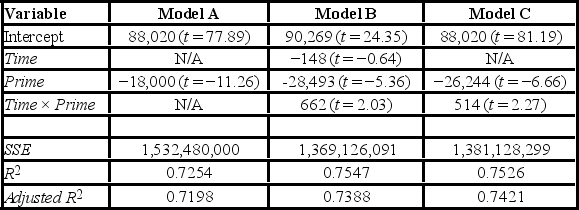Multiple Choice
A researcher wants to examine how the remaining balance on $100,000 loans taken 10 to 20 years ago depends on whether the loan was a prime or subprime loan. He collected a sample of 25 prime loans and 25 subprime loans and recorded the data in the following variables: Balance = the remaining amount of loan to be paid off (in $) ,
Time = the time elapsed from taking the loan,
Prime = a dummy variable assuming 1 for prime loans, and 0 for subprime loans.
The regression results obtained for the models:
Model A: Balance = β0 + β1Prime + ε
Model B: Balance = β0 + β1Time + β2Prime + β3Time × Prime + ε
Model C: Balance = β0 + β1Prime + β2Time × Prime + ε,
Are summarized in the following table.  Note: The values of relevant test statistics are shown in parentheses below the estimated coefficients.
Note: The values of relevant test statistics are shown in parentheses below the estimated coefficients.
Suppose that at a 10% significance level, you do not reject the null hypothesis, H0: β1 = 0, when testing the individual significance of Time in Model B. Would you delete Time from Model B?
A) Yes, removing Time from Model B results in Model C which has a higher adjusted R2.
B) No, removing Time from Model B results in Model C which has a with lower R2.
C) No, Model B has the highest R2, so it should be used for making predictions.
D) Yes, Time should be deleted because we could not prove its significance even for α = 0.10.
Correct Answer:

Verified
Correct Answer:
Verified
Q98: A dummy variable can be used to
Q99: To examine the differences between salaries of
Q100: A dummy variable is also referred to
Q101: A model formulated as y = β<sub>0</sub>
Q102: According to the Center for Disease Control
Q104: For the model y = β<sub>0 </sub>+
Q105: Like any other university, Seton Hall University
Q106: According to the Center for Disease Control
Q107: To examine the differences between salaries of
Q108: A bank manager is interested in assigning